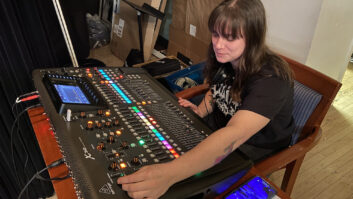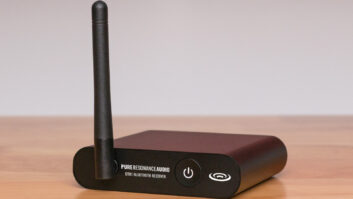CLEVELAND, OH — Aviom’s Pro64® audio network is at the heart of the new educational initiative at Cuyahoga Community College’s Center for Creative Arts.
Located at the school’s metropolitan campus, the recently-constructed Center for Creative Arts is part of the college’s new Creative Arts Division. Along with the new facility is a new educational paradigm. An important element of this educational initiative is to give students the chance to learn hands-on how to record and create mixes on a daily basis. An Aviom Pro64 Series audio network allows the school to implement its curriculum by providing audio distribution throughout the four-story, 75,000-square-foot structure.
“The school’s goal was to make it so the highest-quality audio signals could be sent from anywhere to anywhere,� says Raymond Kent CTS, LEED AP, Director of the Innovative Technology Design Group at Westlake Reed Leskosky, the AV Technology Consultant for the project. “The more we got into the details of the Aviom system, the more it solidified for me that Aviom really was the right audio distribution product for the job, particularly with the ultra-low latency and the low jitter and wander. One of the other features that I really like about Aviom, particularly because this is a learning institution, is the ease of connectivity and the ease of use. If you have to reconfigure or add components to it, you don’t need a PhD in computer science like you do with some of the other systems where you’re pulling out a laptop and having to reinitialize IP addresses for every piece of gear.�
The new Center for Creative Arts is home to a large studio equipped with an SSL Duality console, a production control cluster of five different studio/control rooms, including two traditional recording studios with analog desks, two surround mixing rooms and a dedicated mastering room. The facility also features a large tiered audio classroom where each student has access to headphones and to the source material. The Center’s three additional audio classrooms include one dedicated to Pro Tools training, a MIDI lab, and a PC lab. The fourth floor has a control room designed by Walter-Storyk Design Group connected to a 2,500-square-foot ensemble recording space dedicated to music and music technology. The control room features a restored vintage Trident 80B console, Sony/MCI JH 24 2� analog multitrack tape machine, iZ RADAR V digital multitrack recorder and extensive outboard racks. In addition, the Center boasts a large black box theater for classes on recording live events.
The Pro64 audio network allows each of these performing and recording spaces to be connected to the various control rooms and teaching spaces as needed, without requiring complicated reprogramming of the system. The main hub of the Aviom network is housed in a machine room in the school’s basement. From this machine room, three Aviom 6416dio Digital I/O Modules, two Aviom MH10f fiber merger hubs, and 18 MH10 Merger Hubs serve as the backbone of three separate audio sub-networks, each distributing up to 64 channels of audio to any of the recording studios within the Center. Production panels located throughout the building allow users to tap into intercom, cue mix feeds for Aviom Personal Mixers, tie lines, SMPTE time code distributed by a dedicated Aviom system, video distribution, and phone lines, as well as the main audio network. These panels allow students and faculty to reconfigure the Aviom sub-networks as needed, without reprogramming and still ensure pristine audio quality and clocking throughout the system.
To augment the permanently installed networking infrastructure, the school has Aviom equipment installed in portable input and output racks. The input racks consist of two 6416m Mic Input Modules, as well as an ASI A-Net Systems Interface module and an A-16D Pro A-Net Distributor for feeding Aviom’s A-16II Personal Mixers, which are used as part of the facility’s cue system. Output racks consist of two 6416o Output Modules, two 6416i Input Modules, and an RCI Remote Control Interface, which is used for connecting an MCS Mic Control Surface to control the Pro64 mic preamp settings remotely. Since several of the studios contain digital consoles, a 6416dio Digital I/O Module is racked separately and can be connected where it’s needed for audio I/O and clock signal.
“The Aviom system is designed to implement the curriculum that we’ve wanted for years but haven’t been able to with a copper system because the cost of all the copper cabling and space constraints,� says Tommy Wiggins, program director of recording arts & technology at Cuyahoga. “The goal of our new initiative is that our students can record music ensembles on a daily basis which will get our students more accustomed to the basics of recording and our student musicians to the recording process. We are the only licensed and certified Pro Tools training site in the state; we demand excellence and Aviom is excellent – the mic pres sound darn good.�
The flexibility of the Pro64 system easily allows Cuyahoga to move and install its input and output racks anywhere within the facility, as well as beyond the school’s walls. The school already has plans to connect to its two other campus locations via the Aviom network.
“When going into this project, the criteria for me were, ‘does it sound good and is it reliable?’ If the signal isn’t passing, you can’t teach,� says Mark Baker, Cuyahoga’s technical support manager. “Aviom’s A-Net protocol seems to be at the top of the heap where latency and sound are concerned. In fact the same integrators and system designers are working at our ancillary campuses on the West Side and on the East Side, where we will also be installing Aviom equipment so we can connect all campuses and sit in our control room downtown and record a show on another campus and adjust the mic preamps remotely.�







